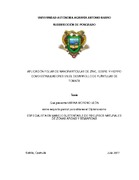Mostrar el registro sencillo del ítem
Aplicación foliar en nanoparticulas zinc, cobre y hierro como estimuladores en el desarrollo de plántulas de tomate
| dc.contributor.advisor | Garza Quiñones, Rosa María | |
| dc.contributor.author | Moreno León, Karina | |
| dc.contributor.other | Martínez Amador, Silvia Yudíth | |
| dc.contributor.other | González Morales, Susana | |
| dc.contributor.other | Mendoza Mendoza, Esmeralda | |
| dc.date.accessioned | 2018-03-02T17:08:48Z | |
| dc.date.available | 2018-03-02T17:08:48Z | |
| dc.date.issued | 2017-07-02 | es_MX |
| dc.identifier.citation | (UAAAN - PSTGRADO - MANEJO SUSTENTABLE DE RECURSOS NATURALES EN ZONAS ÁRIDAS Y SEMIÁRIDAS) | es_MX |
| dc.identifier.uri | http://repositorio.uaaan.mx:8080/xmlui/handle/123456789/42925 | |
| dc.description | Se comprobó la viabilidad del método de química verde empleado en la preparación de NPs de ZnO, CuO y Fe2O3. Las partículas sintetizadas mostraron tamaños de cristalita de 45, 30 y 16 nm respectivamente. El uso de NPs de ZnO, CuO y Fe2O3 mostró un desarrollo favorable en las plántulas de tomate, sobre todo en altura y diámetro de tallo, además de estimular la floración temprana en todos los tratamientos en comparación con el control | |
| dc.description.abstract | "El uso de la nanotecnología en distintos campos ha tenido un repunte en los últimos años, y en la agricultura no es la excepción, ya que existen diversos reportes del uso de nanomateriales en beneficio de los cultivos agrícolas, destacando sus efectos en la nutrición y protección de los cultivos. Ante este panorama, el presente trabajo de investigación tiene como objetivo estudiar el efecto de aplicaciones foliares de nanopartículas (NPs) de zinc, cobre y hierro en las variables agronómicas y fisiológicas en plántulas. Las NPs empleadas fueron sintetizadas por un método de química verde en el Departamento de Materiales Avanzados del Centro de Investigación en Química Aplicada (CIQA), mientras que la evaluación en campo de las NPs se realizó en el invernadero del Departamento de Horticultura, en la Universidad Autónoma Agraria Antonio Narro (UAAAN), utilizando como modelo biológico plántulas de tomate. La aplicación de las NPs en plántulas de tomate 15 días después del trasplante (DDT) constó de cinco tratamientos tal y como se describen a continuación: 1) testigo absoluto, 2) NPs de ZnO a 0.6 mg L-1 3) NPs.de CuO a 0.3 mg L-1, 4) NPs de Fe2O3 a 0.6 mg L-1 y 5) NPs de CuO+ZnO+Fe2O3 a 0.6,0.3 y 0.6 mg L-1. Respectivamente. A los 21 DDT se realizó el primer muestreo de variables agronómicas y fisiológicas, llevando acabo a los 30 DDT el segundo muestreo en el que además de variables mencionadas previamente se determinó la vitamina C, proteínas totales en hoja y la biomasa fresca y seca de la parte aérea y de la raíz. En esta investigación se encontró que la aplicación de las NPs generó el crecimiento e incremento del diámetro del tallo y favoreció la floración." | es_MX |
| dc.description.abstract | "The use of nanotechnology in different fields has seen a rebound in recent years, and in agriculture is no exception, as there are various reports of the use of nanomaterials to benefit agricultural crops, highlighting their effects on nutrition and protection of crops. The objective of this research is to study the effect of foliar applications of nanoparticles (NPs) of zinc, copper and iron on the agronomic and physiological variables in seedlings. The NPs used were synthesized by a green chemistry method in the Department of Advanced Materials of the Applied Chemistry Research Center (CIQA), while field evaluation of NPs was carried out in a greenhouse of the Department of Horticulture, University Autonomous Agrarian Antonio Narro (UAAAN), using tomato seedlings as biological model. The application of NPs to tomato seedlings was 15 days after transplantation (DAT) and consisted of five treatments as described below: 1) absolute control, 2) NPs of ZnO 0.6mg L-1, 3) NPs of CuO 0.3 mg L-1, 4) NPs of Fe2O3 0.6 mg L-1 and 5) NPs of CuO + ZnO + Fe2O3 0.6, 0.3 and 0.6 mg L-1 respectively. The first sampling of agronomic and physiological variables was carried out at 21 DAT, and the second sampling was carried out at 30 DAT, taking previously mentioned variables and C vitamin, total leaf proteins and fresh and dry biomass of aerial and root were determined. In this research, we was found that the application of the NPs generated the growth and increase the stem diameter and favored the flowering." | |
| dc.format | ||
| dc.language | Español | |
| dc.publisher | Universidad Autónoma Agraria Antonio Narro | |
| dc.rights | Acceso Abierto | |
| dc.rights.uri | CC BY-NC-ND - Atribución-NoComercial-SinDerivadas | |
| dc.subject | CIENCIAS AGROPECUARIAS Y BIOTECNOLOGÍA | |
| dc.subject.other | Tomate | |
| dc.subject.other | Plantulas | |
| dc.subject.other | Nanopartículas | |
| dc.subject.other | Desarrollo | |
| dc.title | Aplicación foliar en nanoparticulas zinc, cobre y hierro como estimuladores en el desarrollo de plántulas de tomate | es_MX |
| dc.type | Tesis de maestría | es_MX |
| dc.type.version | Versión publicada | |
| dc.audience | Estudiantes | |
| dc.audience | Investigadores | |
| dc.publisher.place | Saltillo, Coahuila, México | es_MX |
| dc.type.thesis | Digital |
